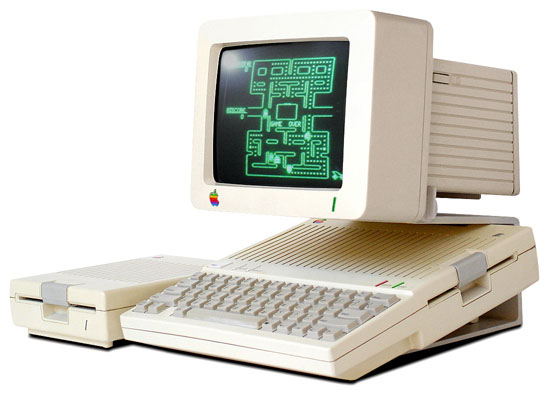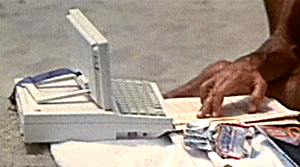|
|---|
History of the Apple Computer Corporation |
- 1973: Stephen Wozniak joins Hewlett Packard.
- 1976: Wozniak proposes that HP create a personal computer. He is rejected.
- 1976: March - Steve Wozniak and Steve Jobs finish work on a computer circuit board, that they call
the Apple I computer.
- 1976: April - Steve Jobs and Steve Wozniak form the Apple Computer Company, on April Fool's Day.
- 1976: July - The Apple I computer board is sold in kit form, and delivered to stores by Steve Jobs
and Steve Wozniak. Price: US$666.66.
- 1976: August - Steve Wozniak begins work on the Apple II.
- 1976: October - Wozniak remains at HP, but is soon convinced that he should leave and join Apple Computer.
- 1976: December - Steve Wozniak and Randy Wigginton demonstrate the first prototype Apple II at a
Homebrew Computer Club meeting.
- 1977: March - Apple Computer moves from Jobs' garage to an office in Cupertino.
- 1977: April - Apple Computer delivers its first Apple II system, for $1295.
- 1977: May - 10 months after its introduction, 175 Apple I kits have sold.
- 1978: Apple Computer begins work on an enhanced Apple II with custom chips, code-named Annie.
- 1978: Apple Computer begins work on a supercomputer with a bit-sliced architecture, code-named Lisa.
- 1979: June - Apple Computer introduces the Apple II Plus, with 48KB memory, for US$1195.
- 1979: September - Apple Computer sells 35,000 Apple II computers for the fiscal year.
- 1979: October - 2.5 years after the introduction of the Apple II, 50,000 units have been sold.
- 1979: Apple Computer begins work on "Sara", the code name for what will be the Apple III.
- 1980: May - Apple Computer introduces the Apple III.
Price ranges from US$4500 to US$8000.
- 1980: September - Apple Computer sells over 78,000 Apple II computers during the fiscal year.
- 1980: Apple Computer ships the first Apple III units in limited quantity.
- 1980: Apple Computer begins project "Diana", which would become the Apple IIe.
- 1981: September - Apple Computer introduces its first hard drive, the 5MB ProFile, for US$3499.
- 1981: Apple Computer officially reintroduces the Apple III, with improved software and a hard disk.
- 1982: Sales of Apple II Plus to date: 45,000.
- 1982: Sales of all Apple II systems to date: 750,000.
- 1982: Apple Computer becomes the first personal computer company to reach US$1 billion in annual sales.
- 1982: Franklin Computer Corp. unveils the Franklin Ace 1000,
the first legal (at the time) Apple II clone.
- 1983: January - Apple Computer officially unveils the Lisa computer. Its initial price is US$10,000.
During its entire lifetime, only 100,000 units are produced.
- 1983: January - Apple Computer introduces the Apple IIe for US$1400.
- 1983: June - The one millionth Apple II is made.
- 1983: June - Apple Computer begins shipping the Lisa.
- 1983: June - Video Technology introduces the Laser 3000, an Apple II workalike microcomputer.
- 1983: June - Unitronics shows the Sonic, an Apple II workalike microcomputer.
- 1983: July - Apple Computer officially begins marketing the Lisa computer.
- 1983: December - Apple Computer introduces the redesigned Apple III as the Apple III+, for US$3000.
- 1983: December - Apple unveils the new Macintosh to the press.
- 1983: Franklin shows an operating Franklin Ace 1200 Apple II compatible for US$2200.
- 1984: January - Apple releases a new version of the Lisa computer, the Lisa 2. It uses all new software,
as well as the Macintosh operating system.
- 1984: January - Apple Computer's Steve Jobs introduces the Apple Macintosh.
- 1984: April - Apple Computer unveils the Apple IIc, priced at US$1300.
- 1984: April - Apple Computer retires the Apple III and Apple III+, with only 65,000 units sold in total (90,000 made).
- 1984: May - Apple Computer announces that 70,000 Macintosh computers have been shipped in the first 100 days since
its announcement.
- 1984: September - Apple Computer introduces the Macintosh 512K for US$3200.
- 1984: November - The 2 millionth Apple II computer is sold.
- 1984: Apple sells the 250,000th Macintosh system.
- 1985: January - Apple Computer officially renames the Lisa the Macintosh XL.
- 1985: March - Apple Computer introduces the Apple Enhanced IIe.
- 1985: April - The Macintosh XL (formerly called Lisa) is dropped from Apple Computer's product line.
- 1986: January - Apple Computer introduces the Macintosh Plus. Price is US$2600.
- 1986: April - Apple Computer discontinues the original Macintosh and the Macintosh 512K.
- 1986: April - Apple Computer introduces the Macintosh 512K Enhanced, for US$2000.
- 1986: July - Apple Computer discontinues the Macintosh XL.
- 1986: September - Apple Computer introduces the Apple IIGS, with the Apple 3.5 drive, for US$1000.
- 1987: January - Apple Computer introduces the Apple Platinum IIe.
- 1987: March - Apple Computer introduces the open architecture Macintosh II, US$3900.
- 1987: March - Apple Computer makes its 1 millionth Macintosh personal computer.
- 1987: March - Apple Computer introduces the expandable Macintosh SE for US$2900.
- 1987: March - Apple Computer discontinues the Macintosh 512K Enhanced.
- 1987: Apple Computer begins shipping the Macintosh II.
- 1988: September - Apple Computer introduces the Apple IIc Plus for US$1100.
- 1988: September - Apple Computer introduces the Macintosh IIx computer, base price is US$7770.
- 1989: January - Apple Computer introduces the Macintosh SE/30, US$6500.
- 1989: September - Apple Computer announces the Macintosh Portable,
for US$6500.
- 1989: September - Apple Computer announces the Macintosh IIci, for about US$8700.
Source:
Chronology of Events in the History of Microcomputers
| |
|---|
|


